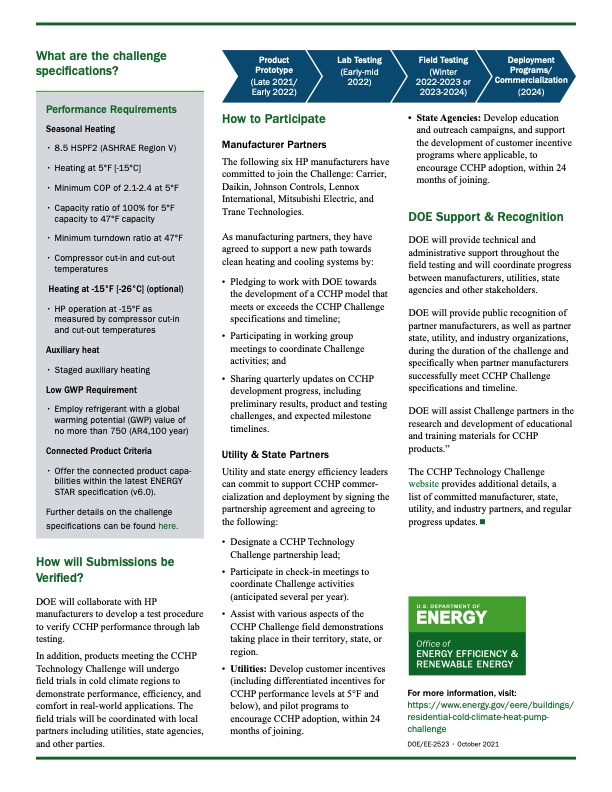
PDF Publication Title:
Text from PDF Page: 002
What are the challenge specifications? Product Prototype (Late 2021/ Early 2022) How to Participate Manufacturer Partners Lab Testing (Early-mid 2022) Field Testing (Winter 2022-2023 or 2023-2024) Deployment Programs/ Commercialization (2024) Performance Requirements Seasonal Heating • 8.5 HSPF2 (ASHRAE Region V) • Heating at 5°F [-15°C] • Minimum COP of 2.1-2.4 at 5°F • Capacity ratio of 100% for 5°F capacity to 47°F capacity • Minimum turndown ratio at 47°F • Compressor cut-in and cut-out temperatures Heating at -15°F [-26°C] (optional) • HP operation at -15°F as measured by compressor cut-in and cut-out temperatures Auxiliary heat • Staged auxiliary heating Low GWP Requirement • Employ refrigerant with a global warming potential (GWP) value of no more than 750 (AR4,100 year) Connected Product Criteria • Offer the connected product capa- bilities within the latest ENERGY STAR specification (v6.0). Further details on the challenge specifications can be found here. How will Submissions be Verified? DOE will collaborate with HP manufacturers to develop a test procedure to verify CCHP performance through lab testing. In addition, products meeting the CCHP Technology Challenge will undergo field trials in cold climate regions to demonstrate performance, efficiency, and comfort in real-world applications. The field trials will be coordinated with local partners including utilities, state agencies, and other parties. For more information, visit: https://www.energy.gov/eere/buildings/ residential-cold-climate-heat-pump- challenge DOE/EE-2523 • October 2021 The following six HP manufacturers have committed to join the Challenge: Carrier, Daikin, Johnson Controls, Lennox International, Mitsubishi Electric, and Trane Technologies. As manufacturing partners, they have agreed to support a new path towards clean heating and cooling systems by: • Pledging to work with DOE towards the development of a CCHP model that meets or exceeds the CCHP Challenge specifications and timeline; • Participating in working group meetings to coordinate Challenge activities; and • Sharing quarterly updates on CCHP development progress, including preliminary results, product and testing challenges, and expected milestone timelines. Utility & State Partners Utility and state energy efficiency leaders can commit to support CCHP commer- cialization and deployment by signing the partnership agreement and agreeing to the following: • Designate a CCHP Technology Challenge partnership lead; • Participate in check-in meetings to coordinate Challenge activities (anticipated several per year). • Assist with various aspects of the CCHP Challenge field demonstrations taking place in their territory, state, or region. • Utilities: Develop customer incentives (including differentiated incentives for CCHP performance levels at 5°F and below), and pilot programs to encourage CCHP adoption, within 24 months of joining. • State Agencies: Develop education and outreach campaigns, and support the development of customer incentive programs where applicable, to encourage CCHP adoption, within 24 months of joining. DOE Support & Recognition DOE will provide technical and administrative support throughout the field testing and will coordinate progress between manufacturers, utilities, state agencies and other stakeholders. DOE will provide public recognition of partner manufacturers, as well as partner state, utility, and industry organizations, during the duration of the challenge and specifically when partner manufacturers successfully meet CCHP Challenge specifications and timeline. DOE will assist Challenge partners in the research and development of educational and training materials for CCHP products.” The CCHP Technology Challenge website provides additional details, a list of committed manufacturer, state, utility, and industry partners, and regular progress updates.PDF Image | Climate Heat Pump Tech Challenge

PDF Search Title:
Climate Heat Pump Tech ChallengeOriginal File Name Searched:
DOE-CCHP-10-28-2021 v2.pdfDIY PDF Search: Google It | Yahoo | Bing
CO2 Organic Rankine Cycle Experimenter Platform The supercritical CO2 phase change system is both a heat pump and organic rankine cycle which can be used for those purposes and as a supercritical extractor for advanced subcritical and supercritical extraction technology. Uses include producing nanoparticles, precious metal CO2 extraction, lithium battery recycling, and other applications... More Info
Heat Pumps CO2 ORC Heat Pump System Platform More Info
| CONTACT TEL: 608-238-6001 Email: greg@infinityturbine.com | RSS | AMP |